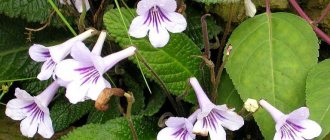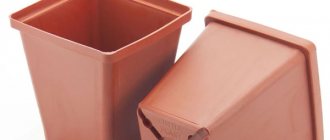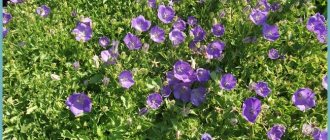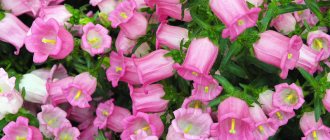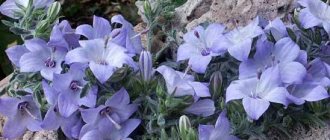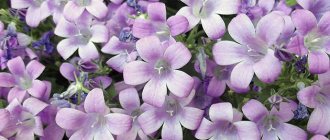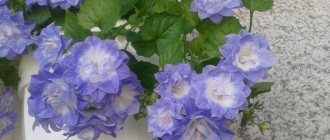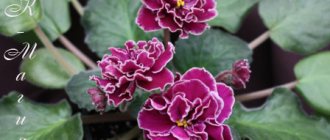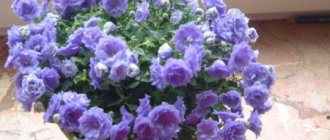Saintpaulias came to Europe from the tropical regions of East Africa. Most of their species grow naturally in the Usambara and Ulugur mountains of Tanzania and Kenya .
They are
called Uzambara or African violet:
- They prefer places shaded from the African sun. There is enough precipitation in these places all year round. Temperatures range from 13 to 30 degrees throughout the year. Quite hot in summer : On steep slopes and banks of streams and rivers;
- Waterfalls and ravines;
- In rock crevices.
Violets are called African or Uzambara violets.
- The flower he grew became noticeable at the exhibition within a year. In 1893;
Attention! There are not many species of them in nature. There are about 20 in total. Numerous hybrids surprise us.
Violet DS-Shining Bell
Among lovers of indoor violets, the variety is very popular and in demand.
What species does it belong to: genus, family
This variety belongs to the Gesneriaceae family Like the whole type of Saintpaulia.
Violet Shining bell belongs to the Gesneriaceae family.
Sauntpoulia ionanta Saintpaulia violetflower or Saintpaulia violetflower. You can see in the photo above DS-Shining bell how it looks and how it blooms.
History and author of the variety
How to achieve success when making flowers? Not only in growing original flowers. But also in the flower business. A serious question for many amateur gardeners. The Enikeev couple (Elena and Pavel) were able to do this:
Breeder Elena.
- We started out trading pears at the market. Where we met;
- The first violet could not withstand its diligent watering when leaving . There was not enough knowledge. And she died. Or maybe more because growing it was a burden rather than a joy;
- The passion for violets appeared a little later. My husband built a greenhouse... For orchids. Business did not work out for them. Profitability was not satisfactory;
- Violets came to the rescue. After purchasing cuttings of varietal violets via the Internet from breeders from Moscow. The first flower show gave a strong positive impulse;
Breeder Pavel. - We created a club of like-minded people, Dimetris. Not so long ago. New violets are more like experiments. Mostly with chimeras. But more begonias;
- And husband Pavel not only created several dozen varieties Streptocarpus. But he also wrote a book about them.
Pavel wrote a book about himself and Elena.
Here's the story. Appearance of the Shining Bell. From the Enikeev family.
Photo and description
Information about the variety of this Saintpaulia and its appearance is scant. And controversial. Much more is known about its creators and their passion for begonias and streptocarpus
- Standard socket. In many ways, its size and appearance depend on the conditions and efforts of lovers of this variety;
This variety has a standard outlet. - The leaves don't really attract attention. Quite large, with a smooth surface. They are a solid dark green color and oval in shape;
- Flowers look festive:
The variety has large flowers.Large wide bells. The unusually colored blue petals resemble a starry sky. With fancy splash strokes from the center;
- The edges are wavy with a white border;
- The core is light. As if illuminated;
- Its dimensions are about 6 cm in diameter.
Features and differences
This violet received an inappropriate name.
A very accurate and apt name . You can't confuse them with others. Flower growers notice that in some plants the blue color takes on purple hues. But just as shining.
Home care
This collection variety does not require any special conditions. As with most Saintpaulias.
Conditions of detention
Many gardeners achieve the promotional coloring of this variety . If optimal conditions have been created.
Deviations from such norms will be noticeable in the color of the flowers and the size of its rosette. And not only. This can also lead to illness.
Choose bright rooms and places . But without exposure to direct sunlight.
Proper watering and fertilizing
- The main nutrients of violets are obtained from water: It is the source of growth and flowering of violets. When used correctly;
- Consider the phases of plant development. And specific conditions. Both in the room and outside the window: Watering is necessary for the plant during the growing season and the formation of the rosette;
- From spring to autumn this should be done 2-3 times a week;
- Cut them back after flowering, when the violets are dormant. Even one a week may be enough.
Important! Use water for irrigation slightly warmer than room temperature. And defended.
- Water Saintpaulias only when necessary. When required: The soil is slightly dry on top;
- It needs to be kept slightly moist.
- Immerse the pot in prepared water. The soil itself picks up the required amount. Just like when watering in a tray. Be sure to remove excess from the pan when moistening the top layer of soil;
Lighting and temperature
Full lighting allows the Shining Bell to shine:
- In summer, this can be achieved without additional devices. On the windowsills. But in winter and far away apartments you can’t do without them;
- These flowers should not be exposed to the hot rays of the sun. They can lead to illness and death. For regulation and protection the following are used: Blinds (not plastic ones);
- Curtains;
- Parchment paper.
Important! Shaded conditions do not always provide the opportunity to create buds and bloom well. Elongation of the petioles also indicates insufficient light.
Air humidity
Dry air is not suitable for this violet .
It must be moistened during intensive operation of heating systems:
- Place the pots in trays with moistened sand and expanded clay;
- Spray the air near plants. But not the plants themselves;
- Place containers of water near the plants.
Priming
Well-prepared soil promotes full growth and beautiful flowering. It is advisable to have:
- Leaf soil;
- Sod land;
- High peat;
- Vermiculite;
- Charcoal;
- River sand (coarse);
- Sphagnum moss.
It will be easy for air to penetrate and allow moisture to pass through . Such soils are offered by specialized stores. In most cases, flower growers use them as a good basis for preparing their options.
The predominance of elements such as phosphorus and potassium is important during the formation of buds and flowering.
Primer for violets can be bought at a flower shop.
Important! The highest quality soil for Saintpaulia with watering and fertilizing is only enough for 9-12 months. It should not be improved, but replaced with a new one.
Pruning and hygiene
Many exhibition visitors pay attention to the beautiful rosette of this variety. It does not form on its own. It is necessary to cut in a timely manner:
- Faded flower stalks;
- Side sockets (stepchildren);
- Old lower leaves;
- Leaves are not growing properly. Or with a light suspicious color.
Reproduction methods
, rooting cuttings is more suitable for this variety And reproduction by children.
Seeds are preferred by specialists and those who like to experiment with new varieties.
When breeding, you can get a sport.
Beautiful sports can also . Like this.
Transplant rules, rejuvenation
- Each Saintpaulia lover has his own principles and rules for replanting his plants. They do this taking into account the condition of the violet and the soil;
- After its abundant flowering, many people do this. And someone in the spring: With a complete replacement of the soil;
- Remove dried and yellowed leaves with petioles;
- Inspect the roots and remove rotten and dry ones;
- Select a container according to the size of the outlet. It is optimal when they are 2-3 times smaller than the outlet;
- It may even require preventive treatments against diseases and pests. Including pots.
- Rooting of the apex during its elongation;
Important! Pay attention to drainage and substrate composition. Taking into account irrigation methods.
How to reproduce?
You can take a cutting and propagate a violet regardless of the season. But at the same time, you can’t just take soil from your garden or garden. Very often it is too dense. If you have no experience at all, you should use store-bought soil. It is pre-selected based on reviews.
More experienced gardeners prepare soil mixtures themselves. They can use various components, but most often they contain washed river sand, peat, green and peat mosses, and turf from the garden. Perlite is added to improve humidity. Violets are bred (with leaves, seeds, and peduncles) in pots with a diameter of 4 cm.
The leaf method involves careful selection of planting material. If he suddenly becomes lethargic, he is simply placed in boiled water with the addition of potassium permanganate for 2-3 hours. Next, the sheet is cut 3 or 4 cm above the base. To trim leaves, you need to use sharp knives or well-sharpened blades. Before this, the cutting part is treated with antiseptic mixtures.
The recommended cutting angle is 45 degrees. There is no need to maintain it exactly; eyeballing will suffice. After the cut, at least 3 cm of the stem should remain on the leaves. Then the sheet is washed and thoroughly dried on towels or clean napkins. In about 20 minutes, the release of plant juice should stop.
Rooting leaves in water most effectively occurs inside dark glass containers. You can take medicine bottles, but you need to wash them thoroughly. Water is used at room temperature. Activated carbon is added. You need to wait about 14 days for the roots to appear.
To learn how to water violets in winter, watch the video below.
Features of flowering, growth and reproduction
This violet blooms beautifully. Everyone confirms this. Who saw her?
Development at home
Good conditions provide:
- Intensive leaf growth;
- Formation of a good rosette and buds.
Owners of this variety note that this happens faster than many other Saintpaulia varieties.
How long does it take to grow an adult plant?
It will take a lot of time to grow adult plants. It depends on many things. And concepts:
- Flower growers consider plants that are beginning to bloom to be mature;
- Where to start counting?
- From the moment of sowing the seeds - up to a year;
- From the beginning of rooting of the cuttings after 7-10 months.
And this bell bloomed even on an unseated baby . You can't call him an adult!
The variety blooms on unplanted plants.
How are varietal characteristics transmitted?
Your friends will also want to have this variety. If they see him at your place. It's not difficult to do:
- Rooting a cut leaf with a petiole: In water;
- In a peat tablet;
- Using sphagnum moss;
- In the ground.
Violets reproduce well by stepsons.
Specifics of flowering
Light core of small size. In the future it increases . This is clearly visible. If you compare only a blossoming flower with a long-blooming one. But the beauty remains! The flower is in a half-open state for a long time. Fully opens before wilting.
The white center of Saintpaulia becomes wider with each flowering.
What do flower stalks look like?
The rosette forms enough peduncles for good flowering . More than 3 bloom at the same time. Or maybe up to 10 pieces. Even though up to 3 flowers are formed on each of them.
Is it possible to achieve cap flowering?
Many buds on strong peduncles allow you to form a beautiful head. What many violet lovers strive for.
Violet has cap flowering.
Bud lifespan
Emerging and growing buds smoothly replace those that are already ending in bloom . And such beauty can delight your eye for a long time.
And the breaks between flowering are only 2-3 months.
Effect of high temperature
Temperature fluctuations are acceptable for growing and flowering Shining Bell. But the plant reacts in its own way to strong deviations. This is especially noticeable in the coloring.
Is it possible to grow completely under artificial light?
Medium bell: varieties, cultivation, breeding
In artificial lighting conditions, violets grow and develop well, thanks to this:
- Saintpaulia can be propagated by leaves all year round;
- place large collections regardless of the location of windows and shelf space.
When installing artificial lighting, it must be taken into account that the process of photosynthesis requires blue and red spectrum.
The following requirements apply to artificial lighting of violets:
- During the period of formation of peduncles, the duration of illumination is increased from 10 to 12-14 hours, or the light intensity is increased, including not one, but several lamps, or the violet is raised closer to the lamp;
- In order not to cause leaf burn, the length of daylight is increased gradually, adding 30 minutes every two days;
- The timing of turning on the lamps is important for plants: it is preferable to do this at the same time every day.
To regulate lighting, a mechanical or electronic timer is used that turns on and off at the right time.
Reviews
Ivan Leonidovich. “The name of the variety doesn’t always mean anything. And here you don’t even need to think. Surprisingly appropriate. The light, even luminous middle is impressive. And such an incomparable contrast of white and blue. She's still growing.
The variety in question attracts many violet lovers.
Its size increases with flowering time. In size it doesn't even reach the standard size. But this is the first flowering. I think she'll get some good size."
Allah. “We need to keep an eye on the outlet. So that it doesn't fall apart. Leaves may stretch out. As well as the temperature. At low levels, white begins to simply reign.”
Separation of children when propagating violets from leaves
After the children appear at the base of the violet stem, they begin to replant it. Small plants are divided so that each baby has at least two leaves and approximately an equal number of roots.
To avoid injury to the violet before separating the children, the ground needs to be watered. As can be seen from the article, if you follow simple rules by planting a violet leaf in the soil, you can get a strong plant. It will delight its owners with beautiful flowers and healthy foliage.
This article discusses two methods that answer the simple question of how to grow a violet from a leaf. Maintaining order will give you strong plants, but you decide for yourself which method of growing violets from leaves to choose. Both methods are good and do not require special knowledge and skills. The main thing is not to rush and follow all the points one by one.
A few more nuances that answer the question of how to plant violets with leaves:
- When planting a plant in the soil, do not forget to make holes in the bottom of the container so that excess moisture can be drained out freely. This must be done to avoid rotting of the plant’s root system.
- The film must be removed periodically to ventilate the planted plant.
Diseases and pests of the variety
Each owner of such Saintpaulia strives to prevent its disease. And get rid of any pests. And there are many of them!
The most dangerous diseases are fungal ones:
- Gray rot;
- Late blight.
Considerable harm can be caused by:
- Thrips;
- Aphid;
- Ticks;
- Nematodes.
What conditions contribute to the emergence and spread of diseases?
These uninvited and unwanted guests may appear with your participation. As well as the fact that their elimination depends on you. If you detect them in a timely manner and take appropriate measures:
- Incorrect watering. Excessive watering at low temperatures is especially dangerous;
- Burning direct sunlight;
- Acquisition of affected new specimens;
- Critically low temperatures and drafts;
- Untimely replacement of already outdated soil.
Preventive measures at home
Create the right conditions for growing Shining Bell. This is the main thing:
- Carry out systematic treatments against diseases and pests. Use reliable tools. Both purchased in stores and simple folk ones;
- Carefully inspect new specimens you purchase for the presence of sores and pests. Provide them with mandatory quarantine and processing upon delivery home;
- Do not bring or leave garden and forest bouquets in the apartment. No matter how beautiful they are!
